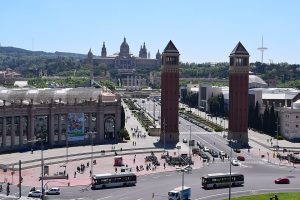Barcelona is not only famous for its modernist architecture and vibrant cultural life, but also for its industrial heritage. Over the centuries, the city has transformed into a hub of innovation and development, leaving behind an industrial legacy that can now be explored through its historic factories, museums, and specialized routes. If you’re interested in discovering a different facet of the city, industrial tourism in Barcelona is an excellent option. Discover this historical route!

What is Industrial Tourism and Why Discover It in Barcelona?
Industrial tourism allows you to learn about a city’s history and evolution through its productive spaces, iconic factories, and the neighborhoods that shaped its economic and social development. In Barcelona, this type of tourism offers the opportunity to immerse yourself in the Industrial Revolution, discover the rise of the textile industry, and explore how the city has turned old factories into cultural spaces.
The Impact of the Industrial Revolution on the City
During the 19th century, Barcelona consolidated itself as one of Spain’s most important industrial cities. The growth of the textile, metallurgy, and transport industries led to the construction of factories, warehouses, and industrial districts that still preserve their essence today.
Industrial Heritage in Barcelona: A Journey Through Time
Today, many of these buildings have been restored and converted into museums, cultural centers, and innovation spaces. This transformation has allowed the city’s industrial memory to be preserved and opened to the public.
Industrial Tourism Routes in Barcelona: The Best Options
Route through the 22@ District: From Factories to Technological Innovation
The 22@ district in Poblenou, one of the main neighborhoods of Barcelona, is a clear example of how the city has reinvented itself. This area, once full of textile factories, has evolved into a hub for technology and creativity. Some must-see stops include:
- Can Framis: a former textile factory turned into a contemporary art museum.
- Torre Glòries: a symbol of the industrial-to-technological shift.
- Espacio Simon 100: a former switch factory transformed into an innovative design center.

Textile Factory Route: 19th Century Barcelona
The rise of the textile industry had a deep impact on the city. On this route, you can visit some of the most iconic spaces of the era:
- Fabra i Coats: One of the most important factories of the 19th century, now transformed into a space for art, creativity, and culture.
- Can Batlló: a former industrial complex that has been converted into a community and entrepreneurship space.
- La Casa de les Aigües de Montcada: located in Montcada i Reixac, it played a key role in the development of industrial water supply.
Other Industrial Routes in Barcelona
If you want to explore beyond textile factories, here are some other interesting routes:
- Industrial Modernism: visit modernist factories like the former headquarters of the Montaner i Simon Publishing House (now the headquarters of the Tàpies Foundation).
- El Rec de Igualada: one of the oldest industrial zones in Catalonia, with leather factories still in operation.
Historical Factories and Industrial Museums in Barcelona
For those wanting to learn more about the city’s industrial history, these restored factories and museums are must-see visits:
Fábrica Casaramona: An Icon of Industrial Modernism
The Fábrica Casaramona, built between 1909 and 1912 at the foot of Montjuïc, is a standout work by modernist architect Josep Puig i Cadafalch. Commissioned by textile industrialist Casimir Casaramona, the factory was designed with innovations such as an internal street system that facilitated the transport of goods and served as fire safety measures.
Additionally, its two towers served as water reservoirs for fire protection, eliminating the need for a chimney by using electricity. After its closure in 1920 due to economic difficulties, the building served various functions, including storage and police headquarters. In 2002, it was restored by the “la Caixa” Foundation and adapted as CaixaForum Barcelona, a cultural center that combines art, culture, and architecture.

Escuela Industrial: An Educational Legacy in the Heart of the City
The Escuela Industrial in Barcelona has its roots in the 19th century, born out of the need to train skilled workers during the Industrial Revolution. Founded in 1870 by the Batlló brothers Feliu and Joan Batlló, the school was established in an extensive complex that spans four blocks of the Eixample.
Over its history, it has witnessed numerous transformations, including the creation of the Real Politécnico Hispano Americano in 1929 and the incorporation of the Escuela de Ingeniería Industrial in 1927. During the Spanish Civil War, it suffered damage from bombings, but was rebuilt and continues to be a reference educational center, offering technical and professional training in industrial engineering.
Can Ricart: Industrial Heritage and Creativity in Poblenou
Located in the Poblenou neighborhood, Can Ricart is an old textile factory recognized as one of the first in Catalonia to produce mechanically printed cotton fabrics. Built in 1855, the factory was a pillar of Barcelona’s industrialization. After its closure, the complex went through periods of abandonment and threats of demolition. However, in recent decades, it has been rehabilitated and transformed into a creative and cultural space. Today, it houses art studios, event spaces, and is an example of urban regeneration in Poblenou, merging its rich industrial heritage with contemporary artistic innovation.
Cemento Asland in Castellar de n’Hug: The Cement Revolution
Located in an old cement factory, this museum explains how the cement industry transformed architecture and construction in Spain. If you’re planning your visit, it opens during the April to December season.
Cerveza Damm: Tradition and Modernity
Here, you can learn about the brewing process of one of Barcelona’s most iconic beers, with tastings included.
How to Organize Your Industrial Tourism Visit in Barcelona
If you want to explore Barcelona’s industrial heritage in an organized way, here are some tips:
- Plan your route in advance to include factories, museums, and thematic routes.
- Look for guided tours, as many factories offer tours with experts in industrial history.
- Book in advance, especially for museums and spaces with limited capacity.
Industrial tourism in Barcelona offers a fascinating perspective on the city, allowing you to discover its evolution through old factories, museums, and specialized routes. Each space tells a story of innovation and transformation, making it an essential experience for those looking for a different journey, away from traditional tourist routes. If you want to immerse yourself in this industrial legacy and make the most of your stay, HCC Hotels is the ideal starting point. Explore, learn, and enjoy a Barcelona full of history and character!














